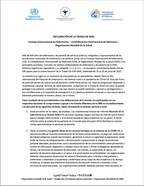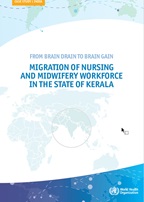
Sarah Wambui Chege and Beatrice Oyuga go over patient files in the labour ward of Mama Lucy Kibaki Hospital, Nairobi, Kenya.
Nursing and midwifery
Technical links
An eventful May, capped by the World Health Assembly, has demonstrated global demand for strategic health and care workforce data, normative guidance and country support. Against health systems under intense pressure and financing tightened, including by ODA cuts (insights from our panel of economists), Member States reaffirmed their support for WHO and for multilateralism, adopted the historic pandemic agreement (Article 7: Health and care workforce), and passed the World Health Assembly Resolution WHA78.16 on Accelerating action on the global health and care workforce by 2030. Additionally, Member States
The Accelerating action resolution was led by the government of the Philippines, along with the governments of Germany, Morocco, Nigeria and Thailand.
Within the official consideration of WHA78.16, Member States expressed approval for the substantive increase in data available through the National Health Workforce Accounts, including within the State of the World’s Nursing Report 2025; concerns, evidence and policy prescriptions on the international migration of health personnel; appreciation for normative tools like the health labour market analysis and for the Working for Health Multi-partner Trust Fund; and support for increased uptake of the Global health and care worker compact to protect and safeguard the workforce.
The cross-cutting nature of health and care workforce strategic policy and investment was a thread running through official discussions including WHO global plan of action to strengthen the role of the health system within a national multisectoral response to address interpersonal violence, Global action plan on climate change and health, Antimicrobial resistance, Health in the 2030 Agenda for Sustainable Development and the Comprehensive implementation plan on maternal, infant and young child nutrition.
Health Workforce was a predominant theme within side events, with at least 37 events delving into topics ranging from public health workforce coordination and investment, health financing, community health workers, migration, regulation, early career health professionals, addressing mental health, occupational health and safety, gender, digital pathways and nursing and midwifery. Overarching themes from these discussions reflected the need for collaboration and partnerships that recognize relative strengths; new approaches to financing, led by countries and supported by partners; and the need to protect and invest in the health and care workforce, including by addressing the projected 11 million health workforce shortage by 2030. Learn more on health workforce strategy & global governance
The 2025 decisions by members of the Organisation for Economic Co-operation and Development (OECD) Development Assistance Committee to freeze or cut official development assistance has created a significant disruption in the global aid ecosystem and national political agendas of low- and-middle income countries . This situation has had immediate consequences for the availability of critical health services, commodities and health and care workers across countries.
A March 2025 WHO rapid assessment found that over half (63%) of WHO country offices reported job-related effects on health and care workers in countries. Budget cuts are expected to reduce countries’ ability to absorb new health and care workers, worsening existing shortages. With reduced absorptive capacity, health systems in Africa are projected to see an increase in the health and care workforce shortage of 600,000 health and care workers by 2030, compared to earlier estimates. Learn more in this blog from our panel of economists.
Who are health and care workers?
The estimated stock of health workers now exceeds 70 million. Shortage estimates decreased steadily since the Global Strategy adoption in 2026, trends that may be linked to investment decisions, the adoption of evidence-based policies and improved data availability.
The pace of progress has slowed, however, and masks diverging trends across and within regions, prompting an upward adjustment to the projected workforce shortage by 2030 to 11 million (compared to the 2022 estimate of a projected 10 million shortage by 2030).
Women comprise 67% of the global health workforce.
Central to the achievement of the Agenda for Sustainable Development is an adequate, equitably distributed and fully supported health workforce. Nurses...
The 72nd World Health Assembly designated 2020 The International Year of the Nurse and the Midwife. This provided a special opportunity to celebrate the...
Around the globe, the nursing profession plays a key role in supporting improved population health outcomes. However, it is recognized in many countries...
Nurses and midwives comprise half of the professional health workforce globally, interact with people from birth to death across all types of settings...

The 9th Triad meeting of WHO, the International Council of Nurses and the International Confederation of Midwives, was held from 9-11 May 2022 . The meeting...

Over 600 government chief nursing and midwifery officers, leaders and representatives of national nursing associations and midwifery associations, together...

India has experienced tremendous growth in its capacity to produce health workers. However, the country still encounters challenges in terms of availability...

Meeting Sustainable Development Goal 3 by 2030—which includes achieving universal health coverage (UHC) and access to quality essential health services...
Technical links